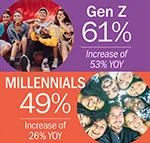 Jennifer Becker Jennifer Becker |
Michael Pollan, author of “The Omnivore’s Dilemma,” said: “Our food system depends on consumers not knowing much about it beyond the price disclosed by the checkout scanner. Cheapness and ignorance are mutually reinforcing.”
Why is ignorance about the food system acceptable? To learn more, G&S conducted a Snap Poll on February 3, 2024, of 313 U.S. adults who are the decision makers regarding grocery purchases. It revealed that 69 percent of respondents want to have more knowledge about how their food gets to market.
People need to eat, and the planet needs to remain viable to grow food. Since consumers desire more information, it’s time to help them see the crossroads before us.
The crossroads
The effects of climate change are apparent. According to the 2023 Global Climate Report, 2023 was the hottest year on record and it’s been 47 years since Earth experienced a colder-than-average temperature. This trend means seasonal and regional temperature extremes affect habitats and intensify rainfall. If temperatures continue to spike around the world, it could affect the ability to grow food.
Aside from shifts in climate, there are more mouths to feed. The United Nations predicts the world’s population will increase to 9.7 billion people in 2050 with a peak at nearly 10.4 billion in the mid-2080s.
With more people needing food and climate change affecting the land on which to grow it, consumers need to understand it’s critical to pivot to a sustainable food system. In comforting news for communicators, 35 percent of respondents to the G&S Snap Poll said they have a basic understanding of what a sustainable food system is and desire to learn more.
| This article is featured in O'Dwyer's Mar. '24 Food & Beverage PR Magazine (view PDF version) |
What is a sustainable food system?
The Academy of Nutrition and Dietetics defines a sustainable food system as providing nutrition and food security without compromising the planet or people, now and in the future. The food system spans the entire cycle—from growing the food through processing and disposal.
Sustainable food systems address three criteria: Economic, Environmental and Social.
- Economic. Everyone involved needs to benefit financially. This includes employees, the government, the businesses involved throughout the food system and consumers through having access to affordable food.
- Social. It needs to be fair for all involved. This means training about hygiene and proper food-handling techniques and providing a safe work environment.
- Environmental. There must be a neutral or positive effect on the environment. This includes maintaining biodiversity, minimizing water consumption, lowering food waste and reducing carbon emissions.
Currently, many see the food system as a drain on natural resources and a contributor to greenhouse gases that harm the environment. This means the government, farmers, food processors, distributors and consumers all have a role to play in achieving a sustainable food system.
This is where communicators can help educate consumers. In the G&S Snap Poll, 41 percent of respondents believed the farmer was responsible for a sustainable food system and only 13 percent believed consumers had a role.
Communication is essential
Communicators can help consumers better understand the food system. Food brands can raise awareness of the issues and provide education through their marketing and communications efforts. If brands are reducing their carbon footprint, consumers should know. If food brands know the farmers who grow their food, and their ability to maintain natural resources, those brands should communicate this to consumers.
As brands are delving into recyclable and biodegradable food packaging, they should share with consumers why this is important. The goal is to reinforce the story of the brand’s commitment to its values and feeding the growing population. This effort can help earn consumer trust and continued purchases. In fact, 63 percent of respondents in the G&S Snap Poll said they would be more likely to purchase brands that disclose these efforts.
As for raising awareness of the part consumers play in the food system, it will take a concerted effort. Education campaigns can explain where food is grown and processed, and how it’s done so sustainability. Meal planning tips could be shared to help consumers plan what they need at the store to help minimize food waste.
We’ve been conditioned to buy in bulk, but having more is not always best nor needed, especially if it will end up as trash. In fact, the EPA says more food reaches landfills than any other material, equaling 24 percent of municipal solid waste. The EPA also estimates 58 percent of methane emissions from these landfills are from discarded food.
While 60 percent of G&S Snap Poll respondents recognize landfill food leads to greenhouse gas emissions, only 33 percent are moderately concerned about this problem. This is an area to help boost consumer awareness and needed action to lead to a sustainable food system.
Communication efforts that put a face to each part of the food life cycle will help consumers be more engaged. If they can relate to the processes and people who help bring food to their tables, there’s a good chance they will focus on more than the cost of their food. Communicating about a complex system—in a compelling and interactive manner—will help consumers better understand the food system.
Measure and learn
Landing pages, social listening, focus groups and market research can help communicators determine if their efforts are getting traction.
In conclusion, 71 percent of respondents in the G&S Snap Poll indicated they are concerned climate change and population growth could impact their access to food. Consumers should understand the effort of growing food, producing it and transporting it to the store for their purchase. They should also understand their part in the food system and their role in sustainability.
To ensure food for all, each person throughout the life cycle can work to create a sustainable food system. The key will be how well communication efforts explain the crossroads before us, and the steps we each take, because the future of food may depend on the actions we take today.
***
Jennifer Becker is Vice President at G&S Business Communications.


 What the biggest meal of the day can teach us about serving up effective nutrition communications campaigns.
What the biggest meal of the day can teach us about serving up effective nutrition communications campaigns. Tips to refine and amplify your CPG brand strategy to win in 2024 and beyond.
Tips to refine and amplify your CPG brand strategy to win in 2024 and beyond. Strategic communications strategies for success in the growing “food is medicine” movement.
Strategic communications strategies for success in the growing “food is medicine” movement. How brands can authentically communicate sustainability issues and create a brand experience that’s compatible with consumers’ values.
How brands can authentically communicate sustainability issues and create a brand experience that’s compatible with consumers’ values. More younger Americans are abstaining from alcohol, according to recent research on the growing sober-curious movement, presenting a challenge—and an opportunity—for beverage marketers in 2024.
More younger Americans are abstaining from alcohol, according to recent research on the growing sober-curious movement, presenting a challenge—and an opportunity—for beverage marketers in 2024.


 Have a comment? Send it to
Have a comment? Send it to 
No comments have been submitted for this story yet.